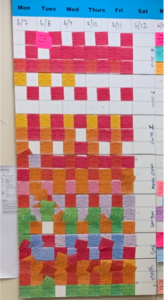- January 24, 2024
- Posted by: Tom Richert
- Category: Performance Guides

Background
The Weekly Work Plan is the core coordination practice from which the Last Planner System® developed. The practice recognizes that people with an understanding of the talent and resources available to perform work are the best people to prepare a final action plan. This guide is provided to identify the essential components of a quality Weekly Work Plan along with additional actions that strengthen the value of the practice.
The purpose of a Weekly Work Plan is to coordinate the work activities of many people working in different professional disciplines on the same project. On a construction project this is especially useful because people are often working in a limited physical space and relying upon the progress of other disciplines while coordinating the delivery of their own materials and equipment within this limited space. While there is a similar need for weekly work planning during the design of a project this guide focuses on weekly planning during the delivery phases of a project.
The Last Planner System prescribes that project “Last Planners®” prepare the Weekly Work Plan. In the construction phases of a project this usually includes a construction management superintendent and superintendents and foremen from each of the trade contractors active on site that week. For purposes of this guide these Last Planners are called “group leaders.”
A Weekly Work Plan ideally identifies the all the daily tasks for the following week planned by group leaders for the people they lead. This daily standard is a baseline recommendation in the 2020 Benchmark for the Last Planner System published by the Project Production Systems Laboratory, authored by Glenn Ballard and Iris Tommelein. The Benchmark recommends that projects “plan to the day, though once daily plans approach 100% PPC, the target should change to planning to the half day.” Only a minority of projects currently meet this baseline daily standard.
Group leaders prepare their weekly work plans prior to a weekly plan review meeting with other group leaders, project superintendents and support staff, and ideally owner and design professional representatives. The plans should be based on the project’s lookahead plan, which is a three to ten-week section of the active phase plans for the project.
The core condition of placing work on the weekly plan is that the group leader is reasonably assured that the work will be performed. Weekly Work Plans are considered bundles of commitments that group leaders are making to each other. For their groups to deliver on these commitments they need to be certain that the required information, people, materials, equipment, and authorizations are available. Only the group leaders can make these commitments, which is why weekly planning is their shared responsibility rather than the responsibility of a single individual.
The individual group plans should be provided to the superintendent’s staff a day before the weekly plan review meeting. This allows the superintendent to identify and review any apparent conflicts and concerns with a group leader before the meeting. During the meeting each group leader stands and reviews their work plan with the other group leaders. During this review leaders can discuss questions and concerns and resolve any conflicts or gaps they identify.
Additional information that becomes available between the end of the weekly plan review meeting and the end of the week may require adjustments to the weekly work plan for the following week. At the end of the week, the plan is published and will be the benchmark discussed at daily huddles.
The following are questions about the weekly work planning process.
What technology should projects use for weekly work planning?
There are several Last Planner System based applications available, each with their own sets of advantages and disadvantages. Spreadsheet based weekly work planning templates are also available. There is no ideal solution, so the following considerations should be made when selecting technology for weekly work planning.
- Can group leaders easily divide multi-day tasks from the lookahead plan into daily commitments? Spreadsheet templates allow this to be a simple process. Other approaches may create different levels of difficulty in creating daily commitments.
- Can the weekly work be easily sorted into different views? At times it is beneficial to review work by trade disciplines, and other times by work streams, or areas of the project. Some applications make this an easy task. This is possible with spreadsheets; however, it requires that the templates be organized with desired fields and that all the group leaders’ plan be assembled into a single file. On a large project this combining of spreadsheets can be a substantial amount of work. Some projects using spreadsheet based weekly work plans simply distribute and post individual trade plans.
- Does the technology facilitate tracking Percent Plan Complete, Tasks Anticipated, and Tasks Made Ready? This is a trick question, as no technology is yet tracking Tasks Anticipated or Tasks Made Ready. Several Last Planner System based applications do track Percent Plan Complete. With spreadsheets tracking Percent Plan Complete is a manual process.
 The use of sticky notes for Weekly Work Plans is strongly discouraged. A healthy Weekly Work Plan will have several dozen to hundred of tasks. Because creating that many sticky notes from a less detailed lookahead plan is time-consuming many projects using this approach do not do a thorough job of identifying the work for the week. Those that do create planning boards that are congested and difficult to read.
The use of sticky notes for Weekly Work Plans is strongly discouraged. A healthy Weekly Work Plan will have several dozen to hundred of tasks. Because creating that many sticky notes from a less detailed lookahead plan is time-consuming many projects using this approach do not do a thorough job of identifying the work for the week. Those that do create planning boards that are congested and difficult to read.
The photo to the right is from the early stages of a well-managed project that used the sticky note approach for weekly plan preparation. Later in the project the team requested group leaders complete their plans on spreadsheets. They then used macros to create half-scale sticky notes to post more work on the planning board.
The sticky note approach is difficult to communicate to the field and requires a lot of discipline to maintain adequately. Given the amount of information that is generated and managed at the project weekly level, electronic approaches are strongly recommended.
What day of the week is best for the weekly plan review meeting?
The Weekly Work Plan is being prepared for the following week, so many superintendents and group leaders prefer a weekly meeting that is toward the end of the preceding week. Thursdays are common, as there is more certainty about what work will be ready to be performed the following week. Other projects hold the review earlier in the week for various reasons, including having the planning meeting in advance of a weekly Owner-Architect-Contractor meeting.
On a stable project, meaning work is largely being performed as planned in the phase plans, it should not matter what day the weekly review is held. In all cases, the team has until Friday to adjust the Weekly Work Plan, and on a stable project those adjustments will usually be minor. On a less stable project, especially due to the need to remove many constraints, weekly plan reviews are better held toward the end of the week when group leaders have a clearer understanding of near-term constraints still pending removal.
Some projects schedule early Monday weekly plan review meetings for the balance of that week, with a request that weekly plans are submitted the prior Friday. This is not recommended because it introduces the possibility that individuals group leader plans are not fully coordinated for the work that begins that Monday.
A practice that is discouraged is establishing work weeks that begin on a day other than Monday. For example, holding weekly plan review meetings on Tuesdays for a work week that runs Wednesday through Tuesday. While this has an apparent, though limited, advantage of holding the planning meeting close to the beginning of the work week, a work plan that is interrupted by a weekend break is an awkward planning timeframe and is potentially misaligned with project stakeholder internal resource planning.
Should group leaders prepare a Weekly Work Plan for the individual members of their groups?
No. Group leaders need to retain day-to-day flexibility in individual assignments to address the needs and capabilities of individuals in the group, which can fluctuate daily. Group leaders should involve their group members in the weekly planning process, as they may have perspectives regarding the work that are important to consider.
Creating a daily plan for individuals in the group is a good idea. A daily plan provides alignment on objectives that are practical to visualize and attain. It also helps to uncover any potential gaps in work coverage, plus address work not foreseen in the Weekly Work Plan.
Weekly Work Planning Performance Levels
The following portion of the guide identifies Weekly Work Planning practices at four different levels.
Essential: The minimum required practices for a quality Weekly Work Plan.
Experienced: Additional practices that experienced project teams incorporate into their Weekly Work Planning.
Expert: Practices that support learning throughout the project and the organizations that are part of the project team.
Exceptional: Practices that support rapid learning resulting in an exceptional level of planning and execution expertise.
Essential Weekly Work Planning Practices
- Group leaders prepare and submit their Weekly Work Plans one day before the weekly plan review meeting each week. They understand that they are making a commitment for their groups to complete the work described on their plans as planned.
- No work on the Weekly Work Plans extends into the following week. By the end of the week all work identified on the plans have a measurable completion described. Terms like “50% Electrical Rough-In Complete” are not acceptable. Portions of larger work need to describe the physical extent of the work to be completed. This can be in terms of rooms, areas between column lines, or predetermined zones for the project.
- Each group leader stands and presents their weekly plan during the weekly plan review meeting. They answer questions and address concerns from others in the meeting.
- Every group leader has a copy of the full Weekly Work Plan for the project. The Weekly Work Plan is posted in the field office and in the field.
Experienced Weekly Work Planning Practices
- All the Essential practices.
- Group leaders organize their Weekly Work Plans and into daily commitments.
- Group leaders review their draft Weekly Work Plans with the members of their groups.
- Superintendents rotate responsibility for leading the team reviews of the Weekly Work Plans in the weekly plan review meetings between the group leaders on the project.
Expert Weekly Work Planning Practices
- All the Experienced practices.
- Group leaders organize their Weekly Work Plans and into half-day commitments.
- Group members participate with group leaders in the preparation of each trade’s Weekly Work Plan.
- During the weekly plan review meeting, the Weekly Work Plan for the project is reviewed by workstream, with group leaders describing their work in the context of preceding work completed by other trades, and the handoff of work to the next trades.
Exceptional Weekly Work Planning Practices
- All the Expert practices.
- Each day group leaders prepare hourly targets for each of the following day’s commitments.
- Group leaders have access to information that allows them to develop production rate forecasts for the week based on tasks and crew sizes.
- Group leaders track and record production rates for the day for comparison against forecasts.
Leave a Reply
You must be logged in to post a comment.

